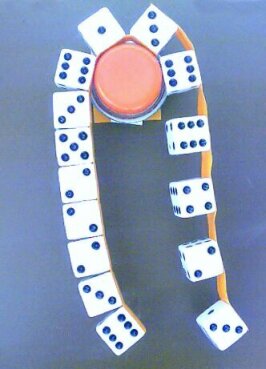Answers
- If the system is disturbed, which way will the pulley turn as
the chain falls? It might turn either direction depending on
the exact starting position and the direction of the disturbing force.
There's always a bit of friction, even when the system is at rest,
and the direction of that force due to friction will determine
which way it turns when the friction is removed. The important point
here is that in the position shown there's no greater likelihood
of motion in one direction than the other.
- How can the weight be larger on the left and the chain still
be in static equilibrium? Do a complete force and torque analysis.
The suspended portions of the chain are analyzed in the same way
we did for the overbalanced chain. The lever arm for one arm is 1.5 cm.
The lever arm for the other is 3 cm. Therefore, without friction,
the balance point would be with one side of the chain weighing twice that
of the other. This fact gives a clue which way the friction is acting
to prevent this chain's motion.

- Why do the suspended dice chains lean toward the right?
Do the force analysis. They lean until the net torque on each hanging
segment becomes zero. For example, on the left side, the leaning will
be such that the center of mass of the suspended portion will be
directly below the point of application of the upward force, at the
radius of 1.5 cm. That point is the upper right corner of the die with
its "3" face showing.
The center of mass of the suspended portion on the right side will
be directly below the lower right corner of the die with its
"6" face showing.
- Why doesn't the upper pulley need teeth to pull the chain up and
over the pulley?
Since the chain never moves, it never goes up and
over the pulley. Also, if the chain did move, by giving it a push,
it would not be the pulley that lifts it, for the pulley has no input source of power.
If, as the inventor assumes, the chain itself is the source of the
power, the chain would move over the smooth pulley by itself. In fact, the little chain-of-dice demo shows that a ball-bearing low friction pulley supports apparently unbalanced weight quite nicely.
Return to the the overbalanced chain problem.
Return to the the main gallery.